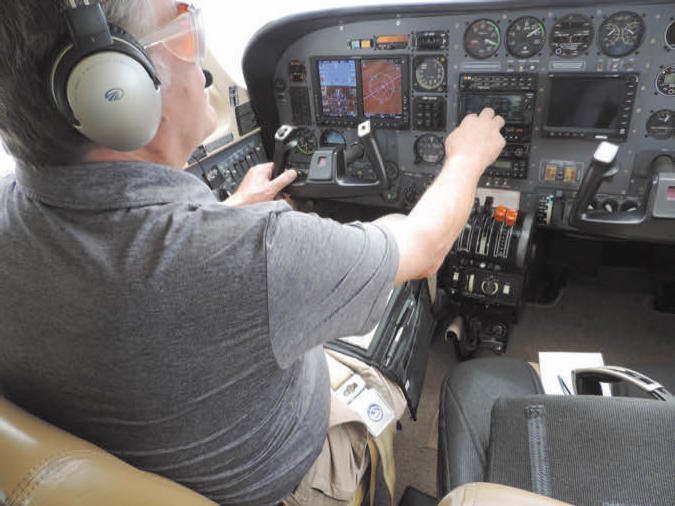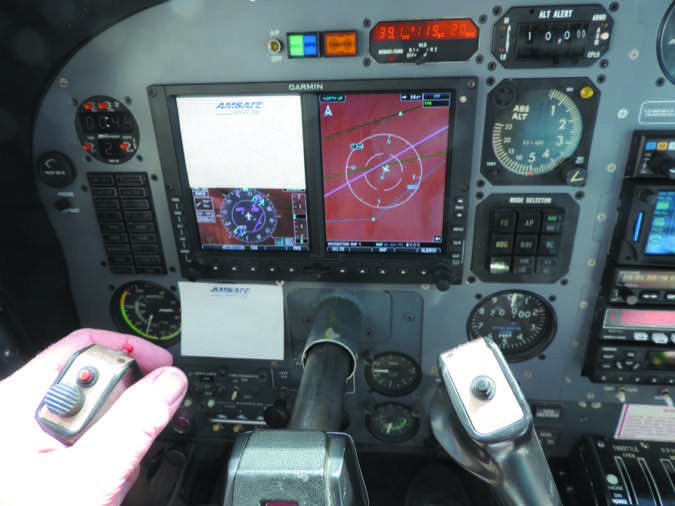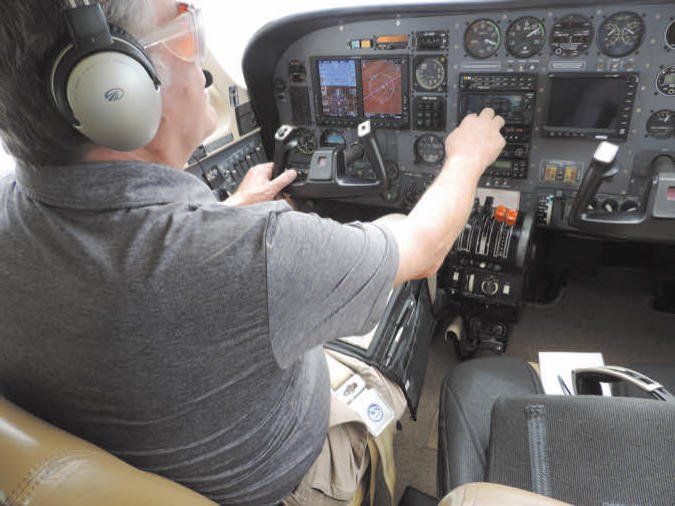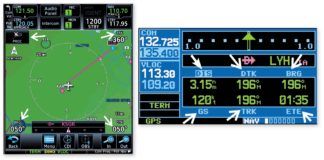After a few days of unusually nasty weather, the day of my postponed IPC dawned bright and clear. There wasn’t even much wind. It was the perfect day to fly, and as it turned out, it seemed like just about every other pilot around thought the same thing. There was traffic everywhere and everyone wanted something different. I was caught in a perfect storm.
Three’s the Charm
I needed an IPC. I’d been flying regularly, but never got more than a few moments boring through the occasional cloud. So, having been fully current about six months ago, I needed to get current again. Rather than just go up with a safety pilot, I decided to ask my friend Ted to actually give me an IPC to work not only on my currency, but on my languishing proficiency.
This was our third scheduled date. On our first proposed schedule, my iPad had just died and I’d sent it out for repair. The repairs took longer than expected and it wasn’t back in time. While I have a panel full of “the good stuff,” I do also rely on the tablet. I concluded that while I was perfectly comfortable continuing a flight with a failed tablet, I’d probably not choose to begin one without that additional layer of information. So, we postponed while I awaited the iPad’s return.
It finally showed up the day before the second scheduled IPC. While that day was certainly good enough to fly, the clouds and ceilings were low enough that we’d be somewhat restricted if we wanted to maintain VMC. Ted and I conferred and concluded that we wanted the flexibility afforded by good VMC, so we postponed another couple days.
Finally, the day arrived and it was perfect—severe clear and relatively (and unusually) light winds, all with unlimited ceiling and visibility. It was a weekday, so we didn’t expect too much activity. We were so wrong.
Prep
With all this delay and rescheduling, Ted undertook the burden to research the new Airman Certification Standards to see what impact they’d have on our IPC. He went so far as to carefully script the whole day, being sure to cover each element: all the approaches, a circle to land, misses out the wazoo, holds, procedure turns, partial panel work (in an airplane with two EFIS and all the backup you could want) and ending with a single-engine approach and landing. It was to be a full day.
Ted’s selected approaches assumed the prevailing winds and normal runways. Since the weather that day was so wonderful, the “prevailing” winds left a lot of flexibility and “normal” runways ended up meaning pretty much whatever people wanted.
And people wanted them all, but I’m getting ahead of myself.
Ready, Set, Wait

Our first surprise came from Ground at my home ‘drome. We were given an uncommon runway for departure. Plus, we were number two—also unusual in my experience. However, we took our time with the runup while number one launched. The departure procedure our script prescribed covered all runways, so it was a simple matter of reprogramming “the box” and it was all good.
We called ready but traffic on crossing runways required us to wait a bit longer. Once airborne, it was the same. Tower was threading multiple aircraft for different runways. Meanwhile, we were handed off to Center and waited.
Center finally got back to us and we reiterated our request to fly the departure procedure followed by some air work. When we were done, we headed to another airport where we’d planned a couple approaches. The number of aircraft trying to talk to Approach reminded me of going into San Francisco in the fog with one of the runways closed while the rest of the Bay enjoyed good VMC. It was try-to-get-a-word-in-edgewise time.
Patience prevailed, and we uttered an edgewise word or two. We made our request for a circle to a low approach to a different runway and miss. That request was a bit much, and both Approach and Tower seemed a little confused, but we muddled through and it worked.
Now It Gets Difficult
Approach was completely saturated with a bunch of requests ranging from simple flight following to a series of conflicting approaches like ours. Of course, at the same time they were busy handling both airliners and practice traffic at the nearby commercial airport.
We made our next request. We were still at the same airport and wanted to miss to a hold at the hold-in-lieu-of-procedure-turn IAF for our next approach. We got a clearance direct to the fix while maintaining VFR. We did that and entered the hold. The radio was so busy as we entered that, given that we were VFR anyway, I opted not to report the hold entry. That was probably a mistake since it kept us out of ATC’s thinking.
I sloppily entered the hold and we did a full circuit while struggling with the autopilot. On the inbound leg, I reported that we were ready for the next approach. The controller asked if we were established on final and I reported we were. From there, our version of events differs from Approach’s.
We Got Spanked
Both Ted and I at the time, and in a later review, believe that after I reported established on final, we were cleared for the approach and told to maintain VFR, which I acknowledged. We even got a frequency change to the tower.
But, when I checked in with Tower, he basically had no idea who we were or where we’d come from. He asked if we’d been cleared for the approach, and I confirmed that we had, as we believed. He checked with Approach, who denied giving us the clearance. Needless to say, the Tower wasn’t happy and we got a tongue lashing. Wanting to avoid an outright argument on a very busy frequency, and trying to take the high road, I replied that we believed we’d been cleared for the approach but would make doubly sure in the future. That seemed to be the end of it. It wasn’t.
As planned, we also missed this approach and headed back to our departure airport. Upon being switched back to Departure, we got another earful. This time, interestingly, it was a different frequency and a different controller. Nonetheless, we got significantly scolded for flying an approach without a clearance. I responded in the same manner as before and we continued our flight.
Ted and I both said we’d need to file an ASRS report.
The IPC continued with about as much precision as possible with the crazy-busy traffic of the day and my own increased stress level from the mishap with ATC. When we got back to the first airport, traffic was even worse with, it seemed, every approach and every runway in use at the same time. Meanwhile, Ted “failed” my EFIS and standby AI for some partial panel work.

The Rest of the Story
How’d the IPC work out? I was quite disappointed in my performance. I always fly using the autopilot to make sure I’ve got mental cycles left to manage the rest of the flight. However, I was too saturated to properly manage the autopilot, so on this IPC I mostly hand flew—of course making it worse. Unnaturally splitting my time between actually handling the airplane and dealing with all the traffic, all the confusion, and the fast-paced, multi-faceted range of approaches, well, let’s just say that my precision in flying the airplane that day didn’t live up to my standards.
Post Mortem
In the few days since, both Ted and I continued analyzing the experience.
I’m well aware of the concept of expectation bias, which, simply put, means that we tend to hear what we expect to hear. Since we expected to get cleared for the approach, that may well be what we thought we heard, but not what was actually said.
Both Ted and I recall getting asked if we were established on final, and we both believe we heard “cleared for the approach” and we both remember hearing, “Maintain VFR.” Plus, we were given the frequency change to Tower. That’s all pretty specific, so I’m going to stick with the statement that we were cleared, while allowing for the possibility we’re both full of poo-poo.
Everybody make mistakes, pilots (and editors), and controllers. I’ve made some really bone-headed egregious errors in my life, only to get corrected by ATC. Nobody’s ever filed a violation on me—yet. So, even if the recordings we decided not to request informally through a friend would prove us right, I didn’t want to risk getting a controller in trouble for an error that, in the final analysis, was an honest mistake that didn’t do anything worse than get a few people worked up.
We concluded that there had been both a controller change (different voice) and a sector split (different frequency). We think it’s likely that the controller, who we believed cleared us for the approach, was so busy that we fell through the cracks during his controller-change briefing combined with the splitting of the radar sector. After all, we were simply VFR traffic on a severe-clear day, and thus not a major priority.
Lessons Learned
There are actually two themes to this story. The first is the IPC itself and the second is the dust up with ATC.
Right after we landed, Ted and I reviewed the overall experience. My initial excuse for doing so badly was what I called the unnatural experience of flying multiple approaches at multiple airports all in the space of less than two hours. My normal use of the airplane is for travel; I take off and fly a departure, spend hours at cruise, then might fly an arrival and approach to a landing. All of that can be programmed from the ground before departure and doesn’t require the flailing all over the panel (and sky) to manage everything thrown at me on the IPC. While true, that’s a copout.
I remember once flying my airliner into Chicago O’Hare at night in heavy snow. They could only keep one runway open at an airport where scheduled arrivals normally use up to three runways at a time. And that one runway they kept open was changing—they’d clear and open a runway, then work on the next runway while traffic used the one just cleared. Used the one just cleared, that is, until it was so snow-covered that it had to be closed and they started using the next runway that had just been cleared. Repeat.
That evening, I had three separate approaches, each to a different runway and each to a miss. We finally diverted to Madison and waited out the snow there.
So, my excuse that all the IPC approaches and confusion were artificial was simply a bunch of hooey. Sure, it’s unusual in the normal course of flying, but it’s something we must be prepared to handle because we can be required to handle it as I’d already experienced.
Ted’s conclusion with which I agree was simply that I’m still not yet familiar enough with my airplane and systems to be sufficiently reactive to a dynamic situation. Oh, and in that dynamic situation, my scan was inadequate. The solution, of course, to both is more work.
I’m hoping the ATC flap remains no more than an opportunity to learn. Either way, though, there are a couple lessons. First, given the frantic pace and chaos often associated with an IPC on a busy day, I think for me it would be best to simply bug out and use a more remote airport or save the IPC for another day when it’s not quite so busy. Why should I add to the controllers’ stress and my own? Maybe it wasn’t such a great idea to wait for perfect weather when we skipped a good-enough weather day with probably far less traffic.
Too many pilots, when they think they’re wrongly accused by ATC, will push back and argue the point. I’ve heard that happen too often, so I know better. There’s no point arguing even if you’re right; it only serves to further frazzle nerves already on edge. Instead, try to de-escalate the situation and, if needed, file an ASRS report later.
Takeaway
An IPC is busy enough without adding chaos from a saturated ATC environment in VFR. I’ll pick my days more carefully. Regardless of whether the controller did clear us for the approach or not, I’ll be more diligent at making sure I explicitly hear those magic words so later I can say for certain I heard them rather than simply believing I did.
Frank Bowlin got his IPC, but along the way decided that he and Ted were going to be spending a lot more time flying together over the next few months.





